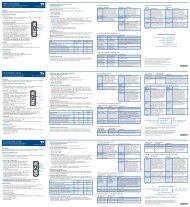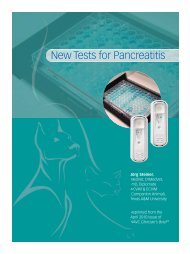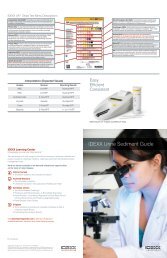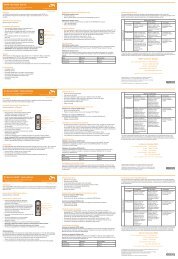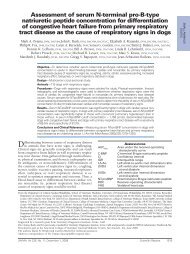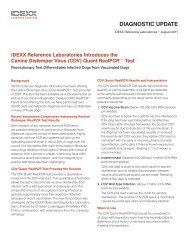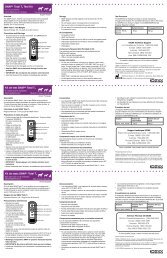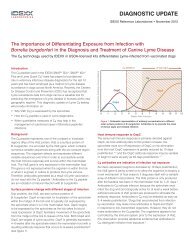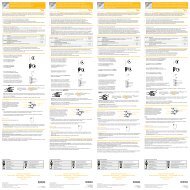SNAP 4Dx Plus Clinical Reference Guide - IDEXX Laboratories
SNAP 4Dx Plus Clinical Reference Guide - IDEXX Laboratories
SNAP 4Dx Plus Clinical Reference Guide - IDEXX Laboratories
You also want an ePaper? Increase the reach of your titles
YUMPU automatically turns print PDFs into web optimized ePapers that Google loves.
Annual screening with<br />
the <strong>SNAP</strong> ® <strong>4Dx</strong> ® <strong>Plus</strong> Test<br />
Screen your canine patients every year with the <strong>SNAP</strong> ® <strong>4Dx</strong> ® <strong>Plus</strong> Test to detect exposure to<br />
pathogens that cause heartworm disease, ehrlichiosis, Lyme disease and anaplasmosis.<br />
Diagnostics for sick patients<br />
Serology and PCR testing options—For a sick dog presenting with clinical signs consistent with a vectorborne<br />
disease, it’s important to consider both serology and PCR testing because they are complementary.<br />
WHAT<br />
TO DO<br />
NEXT?<br />
1<br />
DIAGNOSE<br />
2<br />
3<br />
4<br />
TREAT<br />
MONITOR<br />
PREVENT<br />
A pet’s screening result<br />
and what it means<br />
<br />
<br />
Positive result<br />
The dog has been exposed and may be infected<br />
Perform additional tests to confirm infection<br />
<strong>Clinical</strong> signs and/or laboratory findings indicate either:<br />
Self-limiting infection<br />
No clinical signs or laboratory abnormalities<br />
Subclinical infection<br />
Apparently healthy dogs with laboratory abnormalities<br />
<strong>Clinical</strong> disease<br />
Infected dogs with clinical signs<br />
with or without laboratory abnormalities<br />
If necessary<br />
Retest in 6–12 months<br />
Discuss disease prevention strategies<br />
Negative result<br />
Exposure unlikely<br />
• Review benefits<br />
of prevention<br />
– preventive<br />
– vaccination<br />
• Retest in 1 year<br />
Depending on<br />
the results of a<br />
pet’s screening,<br />
additional testing<br />
or therapies may<br />
be required.<br />
Quick tips to share with<br />
pet owners<br />
• Check your dog for ticks daily.<br />
If you find a tick, remove it right<br />
away (ticks will gravitate to the<br />
head, ears and neck).<br />
• Use a tick preventive on your dog.<br />
• Watch your dog closely for<br />
changes in behavior or appetite<br />
and call your veterinarian with<br />
any concerns.<br />
• Talk with your veterinarian about<br />
ticks and vector-borne disease<br />
in your area.<br />
• If your pet’s test results are<br />
negative, congratulations! Keep<br />
up the good work with regular<br />
preventive screenings and daily<br />
tick checks.<br />
Go to dogsandticks.com<br />
for more information.<br />
Benefits and limitations of each diagnostic method:<br />
Serology<br />
Polymerase chain reaction (PCR)<br />
Measures Antibody response of host Nucleic acid (DNA) from pathogen<br />
Benefits<br />
Limitations<br />
Useful for screening as well<br />
as diagnosis of infection<br />
<strong>Clinical</strong> signs may precede<br />
a measurable antibody<br />
response<br />
Specifically identifies pathogens<br />
indicating active infection<br />
A negative PCR result does not<br />
necessarily rule out infection<br />
Dogs with ehrlichiosis and anaplasmosis may present with clinical signs<br />
at different times after infection. Which sick dog are you dealing with?<br />
Using serology and<br />
PCR together improves<br />
your ability to make a<br />
complete and accurate<br />
diagnosis.<br />
Positive result<br />
Infection or<br />
Recrudescence<br />
PCR<br />
Dog A<br />
presents<br />
Dog B<br />
presents<br />
Serology<br />
Time postinfection<br />
Dog C<br />
presents<br />
When to use the <strong>IDEXX</strong> RealPCR<br />
vector-borne disease panels:<br />
• Sick patients with clinical signs<br />
and/or laboratory abnormalities<br />
consistent with a vector-borne illness<br />
• Patients with subclinical infections<br />
based on history, physical exam,<br />
serology and clinical laboratory<br />
findings<br />
• Monitoring response to therapy—<br />
the Lyme Quant C 6<br />
®<br />
Test can<br />
indicate waning antibody levels,<br />
and for other pathogens, a negative<br />
PCR result indicates a reduction in<br />
pathogen load<br />
••<br />
No single test is sufficient for<br />
diagnosing an infectious disease<br />
in a sick patient. ••<br />
Edward Breitschwerdt, DVM, DACVIM*<br />
Professor, Internal Medicine<br />
College of Veterinary Medicine,<br />
North Carolina State University<br />
*Dr. Breitschwerdt has a business relationship with <strong>IDEXX</strong> pursuant to which he<br />
receives compensation from <strong>IDEXX</strong> from time to time. The views expressed in this<br />
brochure are solely those of Dr. Breitschwerdt.




